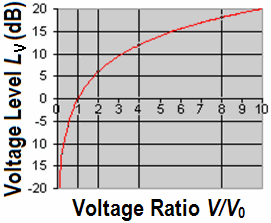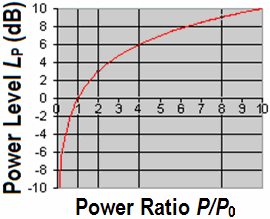

| Deutsche Version |
| A provocative question: Can one ever amplify the power? Electrical voltage and electrical
current can be amplified. Energy can be converted in various forms of energy. To save
energy one wants to produce more power with less energy. The term "amplifier" covers up that the energy comes entirely from the mains and largely leaves the devices as a loss. Because of energy conservation you cannot make a large power from a small power. However, one can at least transfer the data from a weak to a strong current. |
 |
 |
Not used in Audio |
| To use the calculator, simply enter a value. The calculator works in both directions of the ↔ sign. |
In audio engineering "power amplification" is unusual, even
power amplifiers for loudspeakers don't amplify the power.
They amplify the audio voltage moving the speaker coil.
| Power is like all energy quantities primarily a calculated value. |
|
| Decibels are defined as ten times the log of a "power ratio". Decibels convert multiplication
and division calculations into simple addition and subtraction operations. But in Audio we never use the power ratio. We like the voltage, sound pressure, or amplitude ratio. For us decibels are defined as twenty times the log of an amplitude ratio. |
| Ratio (OUT / IN) |
Voltage Gain (dB) |
"Power Gain" (dB) |
| 1/1000 | −60 | −30 |
| 1/100 | −40 | −20 |
| 1/10 | −20 | −10 |
| 1/5 | −14 | −7 |
| 1/2 | −6.02 | −3.01 |
| 1 | 0 | 0 |
| 2 | +6.02 | +3.01 |
| 5 | +14 | +7 |
| 10 | +20 | +10 |
| 100 | +40 | +20 |
| 1000 | +60 | +30 |
| Voltage Gain | Power Gain | |||
| Voltage ratio Factor V2/V1 |
Voltage amplification GV in dB |
Power ratio Factor P2/P1 |
Power amplification GP in dB |
|
| 103 | +60 | 106 | +60 | |
| 102 | +40 | 104 | +40 | |
| 101 | +20 | 102 | +20 | |
| √10 = 3.16 | +10 | 10 | +10 | |
| 2 | +6 | 4 | +6 | |
| √2 = 1.414 | +3 | 2 | +3 | |
| 1 | ±0 | 1 | ±0 | |
| 1/√2 = 0.7071 | −3 | 1/2 = 0.5 | −3 | |
| 1/2 = 0.5 | −6 | 1/4 = 0.25 | −6 | |
| 1/√10 = 0.316 | −10 | 10−1 = 0.1 | −10 | |
| 10−1 = 0.1 | −20 | 10−2 = 0.01 | −20 | |
| 10−2 = 0.01 | −40 | 10−4 = 0.0001 | −40 | |
| 10−3 = 0.001 | −60 | 10−6 = 0.000001 | −60 | |
| V2/V1 = 10(GV in dB/20) | GV = 20×log (V2/V1) | P2/P1 = 10(GP in dB/10) | GP = 10×log (P2/P1) | |
| Voltage gain (dB) = 20×log (Audio output voltage / Audio input voltage). Used in audio. Voltage gain is defined as the ratio of the output voltage to the input voltage in dB. Assume that the input voltage is 10 mV (+10 dBm) and the output voltage is 1 V (1000 mV, +60 dBu). The ratio will be 1000/10 = 100, and the voltage gain will be 20×log 100 = 40 dB. Reference voltage V0 = 1 Volt. Power gain (dB) = 10×log (RF output power / RF input power). Used in RF. Power gain is defined as the ratio of the output power to the input power in dB. Assume that the input power is 10 mW (+10 dBm) and the output power is 1 W (1000 mW, +30 dBm). The ratio will be 1000/10 = 100, and the power gain will be 10×log 100 = 20 dB. Reference power P0 = 1 Watt. |
| back |
Search Engine |
home |